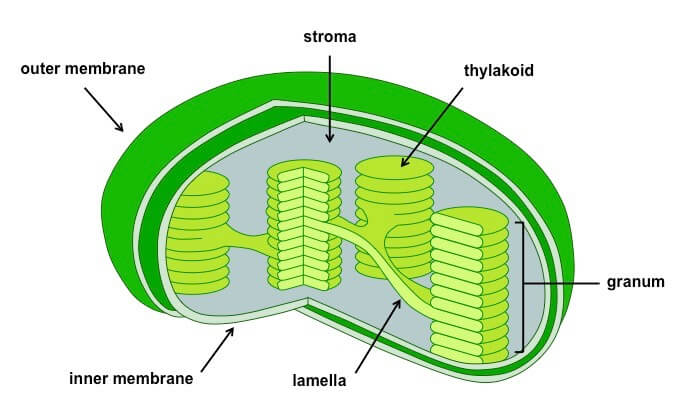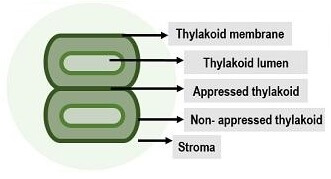Plastids
Plastid is a cell organelle that is found in all plant cells, algae and some protists like Euglena. It has different types. The eukaryotic animal cells generally do not contain plastids. Plastids are pigment containing double membrane bound organelle with their own DNA and ribosome like mitochondria. The major function of plastids is the manufacturing and storage of food.
Besides this, they are the largest cytoplasmic organelle in plant cells. They are formed from proplastids, which are found in embryonic tissue. Proplastids are double membraned structures with stroma and DNA.
The plastids were discovered and named by Ernst Haeckel. However, a clear definition of plastids was given by A.F.W. Schimper.
Types of Plastids:
Plastids can be of different types as listed below;
i) Chloroplasts
Chloroplast is a green plastid as it contains green pigment chlorophyll. It was discovered by Anton van Leeuwenhoek and the term chloroplast was given by A. J. W Schimper in 1883. It is present in all green parts of a plant including green stems and unripened fruits. The green colour is due to the presence of green pigment chlorophyll. However, they are in abundance in the leaves in their mesophyll cells located between the epidermal cells of leaves. So, the leaves generally have more number of chloroplasts than any other part of the same plant.
Number of chloroplasts per cell
The number and shape of chloroplast may vary in the cells of a species. The Chlamydomonas and Ulothrix contain only one chloroplast in their cell. In spirogyra, there can be 1 to 15 chloroplasts per cell. Its number can be 20 to 40 per cell in higher plants. It can be up to 500 per cell in the intermodal cell of Chara.
Size and Shape of Chloroplast
The diameter of chloroplast ranges from 4 to 6 micrometre and it contains 70S type of ribosomes. The shape of the chloroplast is also variable. Some of its most common shapes include a cup or horseshoe-shaped, which is found in Chlamydomonas. Girdle shaped chloroplast is found in the cells of Ulothrix. The ribbon-shaped chloroplast is found in spirogyra. In higher plants, the shape is mostly oval or discoidal. So, both the number and shape of this organelle are variable.
Furthermore, the chloroplast is a dimorphic organelle which means it exists in two forms agranal and granal.
Granal chloroplast contains the grana along with stroma and stroma lamella, whereas, the agranal chloroplast does not have grana, it has only stroma and some stroma lamella. Granal chloroplast is found in the mesophyll cells of C3 and C4 plants. Whereas, the agranal chloroplast are found in C4 plants.
Structure of Chloroplast
Chloroplast has a double-membrane. The outer membrane contains less protein and is permeable and smooth. It has porins that act as pores for small molecules, whereas, the inner membrane, which is also smooth, contains more proteins and is semipermeable. The space between membranes is called inner membrane space. It makes use of membrane transporters to allow molecules to pass. Furthermore, proteins, ribosomes and DNA are embedded in the stroma. So, it is also a self-replicating organelle like mitochondria.

The inner space or space enclosed by the inner membrane contains a material called the stroma. The stroma is rich in enzymes that are required for the dark reaction such as Rubisco (Ribulose bisphosphate carboxylase); it is the most abundant protein in the world. It helps in accepting or in the fixation of carbon dioxide in dark reaction.
The inner membrane of chloroplast shows invagination or gives rise to infold. On these infolds, flat disc-like structures are present, which look like a pile of coins and are called thylakoids (singular: thylakoid). Each stack of thylakoids is called granum (plural: grana). The lumen of the thylakoids is connected with the inner membrane. The grana or thylakoids of different grana are connected with each other and with the inner membrane through stroma lamella.
The term thylakoid was given by Menke in 1961. There are around 20 to 50 thylakoids that lie above one another to form a granum (plural; grana). There can be 40 to 100 grana in the stroma of the chloroplast.
Like Mitochondria, the chloroplast is also a semi-autonomous organelle as it has its own circular DNA and ribosomes. Its ribosomes are 70S type and are called plastido-ribosomes. Besides this, the stroma is also rich in divalent ions such as Mg2+, Mn2+, and Fe2+.
The chlorophyll pigments are present in the membrane of thylakoids. These pigments are present in the form of Quantasomes, which were discovered by Park and Biggins in 1954. Each quantasome is a group of around 230 chlorophyll molecules or pigments that include different types of chlorophylls including carotenoids, xanthophylls, phycobilins. A single chlorophyll molecule comprises a porphyrin ring and a long phytol chain attached to the ring. The magnesium element is located at the centre of the porphyrin ring.
These pigments in quantasome along with proteins form the entire unit that harvests the light. This unit is called the light-harvesting complex and it contains photosystem 1 and photosystem 2.
In thylakoids, the part of their membrane that is in contact with each other not with the stroma is called the appressed part. Whereas, the part of their membrane that is in contact with the stroma is called the non-appressed part.

The photosystem PS2 is present in the appressed part. Whereas, PS1 is present in the non-appressed part.
Chemical composition of chloroplast
It has 30 to 55 % of protein by dry weight (excluding water). Other components include lipids (20-30% by dry weight), Chlorophyll (9 % by dry weight), carotenoids (4.5 %), RNA (3-7%), DNA (0.1%) and a very small amount of vitamin K and E, cytochrome F, Mg, Zn, P.
Functions of chloroplast
- The major function of the chloroplast is photosynthesis in which it converts carbon dioxide and water into glucose in the presence of sunlight. The light reaction takes place in the thylakoid, whereas, the dark reaction takes place in the stroma.
- It absorbs sunlight that is needed for photosynthesis. So, it serves as a site of photosynthesis, a process by which plants produce their food.
- It also plays a role in cytoplasmic inheritance as it contains circular DNA (its own genetic material).
ii) Chromoplasts: They are coloured plastids that contain coloured pigments like yellow, orange, red carotenoids and other coloured pigments except for green coloured pigments. So, they do not have chlorophyll. We can say that this type of plastids contains coloured pigments except for green pigment. So, any plastid that contains coloured pigment apart from green is called a chromoplast. They are found in photosynthetic eukaryotes and are responsible for different colours of flowers, fruits, leaves, roots like a carrot.
The chromoplasts arise from proplastids and chloroplast, i.e. the chloroplast can change into chromoplast, for example, when green tomato turns into red tomato on ripening and when green leaves change their colour during autumn. The major function of chromoplasts is to attract insects for pollination by providing attractive colours to flowers and fruits.
iii) Leucoplast: This type of plastid is an unpigmented organelle. It does not contain any pigment and grana. It is usually present in the non-photosynthetic parts of a plant such as underground parts of the plants like roots and tubers. However, they are also present in some stems. Leucoplasts perform specialized functions such as the storage of starch, lipids, and proteins. So, the major function of the leucoplast is the storage of food. Besides this, their shape is variable such as oval, rod-like, filamentous or spherical.
Types of leucoplast:
Leucoplasts are of various types depending on the food molecules stored by them. Such as,
- Amyloplast: This type of leucoplast store carbohydrate molecules. They are oval in shape and can be found in potato tubers.
- Elaioplast: They are oval-shaped plastids. They store oil droplets or fatty acids or fat. They are found in oilseeds, such as caster seeds, groundnut, sunflower seeds, mustard seeds, etc.
- Proteinoplast: They are also known as Aleuroplast. They store protein grains. They are found in pulses such as maize.
- Etioplasts: They are colourless plastids and found in those parts of plants that are not exposed to sunlight. Due to the absence of light, their chlorophyll pigment is destroyed. In the presence of sunlight, they can convert into the chloroplast.
Besides this, the plastids are interconvertible, which means one type of plastid can be converted into another type of plastid. For example, leucoplast can develop pigment and change into chromoplasts and vice versa.
